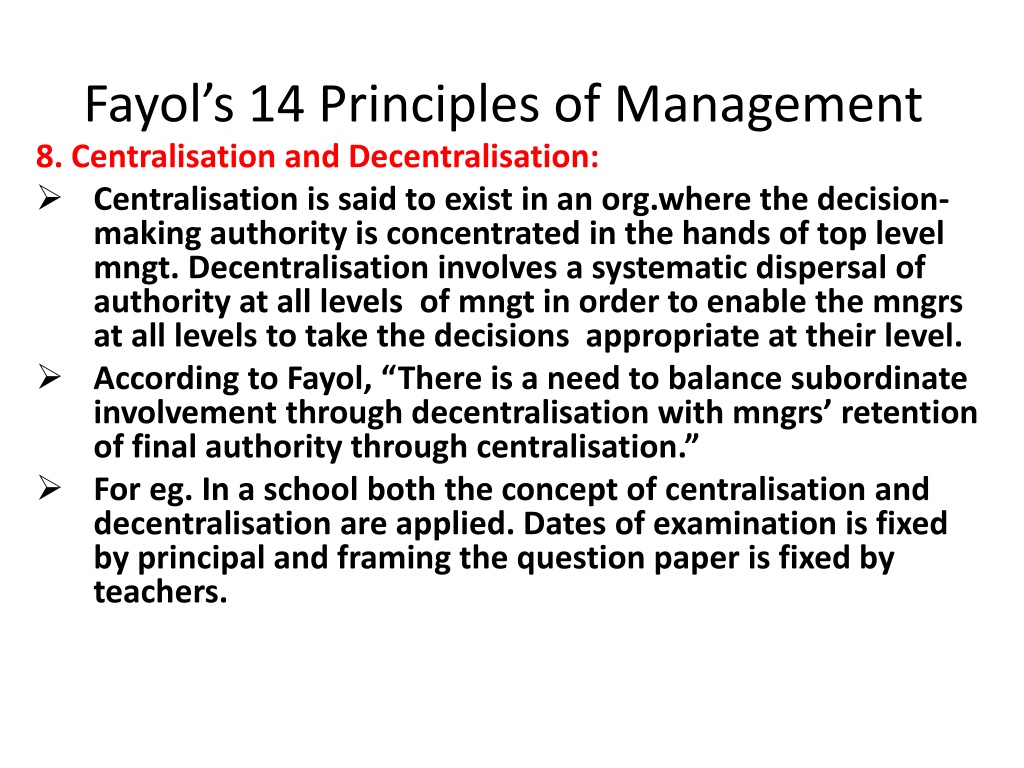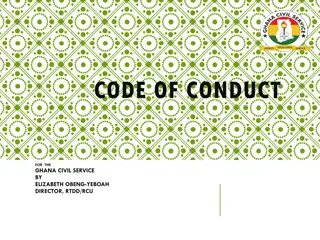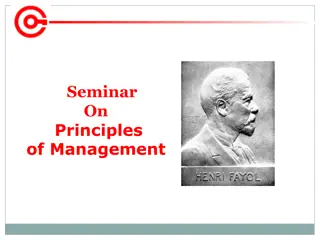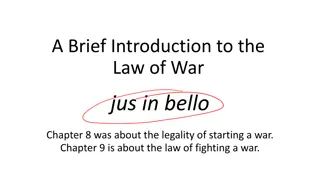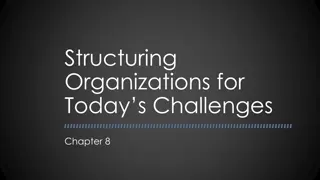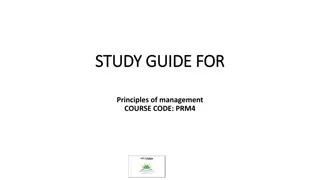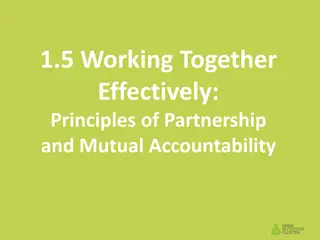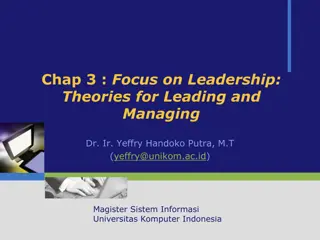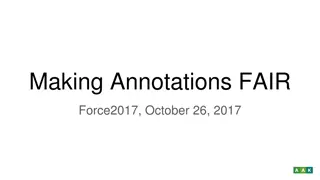Principles of Management According to Fayol
Fayol's 14 Principles of Management include concepts such as centralisation and decentralisation, scalar chain, and order. Centralisation concentrates decision-making authority at the top level, while decentralisation disperses it across management levels. Scalar chain emphasizes the formal lines of authority from top to bottom, with Gang Plank for emergency communication. Order ensures smooth functioning by having a place for everything and everything in its place, both in material and social aspects within an organization.
Download Presentation

Please find below an Image/Link to download the presentation.
The content on the website is provided AS IS for your information and personal use only. It may not be sold, licensed, or shared on other websites without obtaining consent from the author.If you encounter any issues during the download, it is possible that the publisher has removed the file from their server.
You are allowed to download the files provided on this website for personal or commercial use, subject to the condition that they are used lawfully. All files are the property of their respective owners.
The content on the website is provided AS IS for your information and personal use only. It may not be sold, licensed, or shared on other websites without obtaining consent from the author.
E N D
Presentation Transcript
Fayols 14 Principles of Management 8. Centralisation and Decentralisation: Centralisation is said to exist in an org.where the decision- making authority is concentrated in the hands of top level mngt. Decentralisation involves a systematic dispersal of authority at all levels of mngt in order to enable the mngrs at all levels to take the decisions appropriate at their level. According to Fayol, There is a need to balance subordinate involvement through decentralisation with mngrs retention of final authority through centralisation. For eg. In a school both the concept of centralisation and decentralisation are applied. Dates of examination is fixed by principal and framing the question paper is fixed by teachers.
Fayols 14 Principles of Management Centralisation and Decentralisation: Positive Effects of application Negative Effects of violation Ensures quick decision making Org. may not function smoothly Effective realisation of goals Non-achievement of goals Reduce burden of mngrs Insufficient authority leads to work disruption Ensure smooth working of org Delay in decision making
Fayols 14 Principles of Management 9. Scalar Chain: Org. should have a chain of authority and commn that runs from top to bottom and should be followed by mngrs and the subordinates. According to Fayol, The formal lines of authority from highest to lowest ranks are known as scalar chain. However in order to ensure speedy commn during emergencies, Gang Plank is a shorter route that has been provided.
Fayols 14 Principles of Management 9. Scalar Chain: For eg. A is one head who has two lines of commn. In case of emergency E communicates to O which is known as Gang Plank
Fayols 14 Principles of Management Scalar Chain: Positive Effects of application Negative Effects of violation Leads to systematic working Adverse effect on work Increases work efficiency Non-achievement of goals Facilitates control of commn Difficult to create coordination Ensure smooth commn Chaos and confusions
Fayols 14 Principles of Management 10. Order: The principle of order facilitates smooth working of an org. by ensuring easy and timely location of people and things whenever required. According to Fayol, The practice of a place for everything and everything in its place should be followed within every org. Material order and Social Order. For eg, in a school there is place for books in library, sports equipments in sports room, staffs in staff room etc.
Fayols 14 Principles of Management Order: Positive Effects of application Negative Effects of violation Leads to systematic working Adverse effect on work efficiency Increases work efficiency Non-achievement of goals Facilitates coordination Leads to wastage of time and resources Leads to optimum utilisation of resources Chaos and confusions
Fayols 14 Principles of Management 11. Equity: This principle urges the mngrs to praactice kindliness and justice in their behaviour towards their workers. According to Fayol, Good sense and experience are needed to ensure fairness to all employees who should be treated as fairly as possible. For eg, Manas works as a Project Mngr in an IT co. His team comprises of 8 people, belonging to diff nationalities. While dealing with his team members, he ensures that he never discriminate among them on the basis of nationality, gender etc. This has created a good work environment.
Fayols 14 Principles of Management Equity: Positive Effects of application Negative Effects of violation Ensures loyalty and devotion Bitter relationship bet mngr and workers Realisation of goals Non-achievement of goals Enhances job satisfaction of employees High labour turnover Creates healthy work environment Creates conflicts
Fayols 14 Principles of Management 12. Stability of Personnel: This principle urges that proper recruitment should be done with minimum fixed tenure so that the employees can prove their potential. According to Fayol, Employee turnover should be minimised to maintain operational efficiency in the org. For eg, Sagar joined a well known chain of hotels in India. Within a year of joining the org, he decided to quit the job. His decision was due to the frustration that he felt for being shifted five times within this time from one branch to another.
Fayols 14 Principles of Management Stability of Personnel: Positive Effects of application Negative Effects of violation Instills a feeling of job security Frequent transfer leads to job satisfaction Realisation of goals Non-achievement of goals Enhances job satisfaction of employees High labour turnover Leads to utilisation of resources High expenses on recruitment and selection
Fayols 14 Principles of Management 13. Initiative: The mngt should encourage initiative among employees, but at the same time it should not create adverse impact on the well being of the org. Employees should be rewarded for fruitful suggestions. According to Fayol, Initiative means taking the first step with self-motivation. The workers should be encouraged to develop and carry out their plans for improvement. For eg, Before setting up of plan the mngr must welcome the suggestions and ideas of employees to allow their max participation.
Fayols 14 Principles of Management Initiative: Positive Effects of application Negative Effects of violation Increases the self confidence and morale of workers Non-healthy relationship bet mngt and workers Realisation of goals Non-achievement of goals Enhances job satisfaction of employees High labour turnover Helps to develop sense of belonginess Restricts the creativity of employees
Fayols 14 Principles of Management 14. Espirit De Corps: This approach gives rise to a spirit of mutual trust and belongingness among team members. According to Fayol, Mngt should promote a team spirit of unity and harmony among employees . For eg, if the prodn mngr assigned a target of mfg 100 units to a group of 10 members, they will concentrate on achieving the target of 100 units and not 10 units as team members.
Fayols 14 Principles of Management Espirit De Corps: Positive Effects of application Negative Effects of violation Helps to develop a feeling of trust, team spirit and harmony Non-healthy relationship bet mngt and workers Realisation of goals Non-achievement of goals Enhances job satisfaction of employees High labour turnover Healthy work environment Restricts the creativity of employees
F W Taylors ScientificManagement 1. Introduction: 1856-1915 Fredrick Winslow Taylor was an American mechanical engineer who wanted to improve industrial efficiency by adopting scientific methods of production. In 1884, he became an executive at Midvale Steel Co. because of his leadership abilities. He pioneered a new and efficient system in order to increase production.
Taylors Principles of Management 1. Science not Rule of Thumb Taylor suggested that management practices should be developed through study and analysis and not through hit and trial method. The scientific method involved investigation of traditional method through work study and developing a standard method which would be followed throughout the org. For eg, containers of irons into trucks can be done scientifically rather than through human methods. This will save human energy as well as wastage of time and materials.
Taylors Principles of Management 2. Harmony, Not Discord There are two groups in a company-workers group and management groups which can become rivals of each other. Taylor insisted on bringing mental revolution which means complete change of attitude and outlook for each other. He advocated paternalistic style of management practiced in Japanese companies. For eg, Japanese workers do not go on strike. Instead they wear black ribbon to show dissatisfaction and to gain sympathy of managers.
Taylors Principles of Management 3. Cooperation not individualism Taylor stresses that should be complete cooperation between the workers and the management instead of individualism. Management should provide necessary help, encouragement, equal division of work and responsibility, participation of workers in decision making. Workers should avoid going on strike but should have open communication. For eg, While assigning works, management should ask the workers about their interest and the workers interest is developed which leads to efficiency.
Taylors Principles of Management 4. Development of workers to their greatest efficiency and prosperity. Taylor stresses great care should be taken when selecting the workers and after selecting they must be given job according to their qualification. Employees must be sent for training from time to time to update their knowledge. This will ensure their greatest efficiency and prosperity for both company and workers.
Scientific Techniques of Taylor 1. Functional foremanship. Meaning: Under this technique, each worker is closely observed by eight bosses, each of whom is an expert in a specific task. Purpose: It was not possible for a single person to become expert in every aspect of a job. Functional foremanship increased efficiency of workers. Process: Work is divided into two depts- planning dept and production department.
Scientific Techniques of Taylor 1. Functional foremanship. Actual perform ance with planned per Total cost and time taken for each job Availability of RM, tools & equipments to workers Repair machine s Monitors actual work with time schedule Rules & regulations are strictly followed Method of doing a job Sched uling activities
Scientific Techniques of Taylor 2. Standardisation & simplification of work. Meaning: Standardisation means conforming to predetermined requirements in terms of size, design, weight, quality etc. Purpose: To develop excellence & quality in materials. To formulate standards of performance of men and machines. Process: Work is standardised into two aspects- inputs (work methods, tools, equipments, RM) and outputs(Production category on the basis of size, type, quality and features)
Scientific Techniques of Taylor 2. Standardisation & simplification of work. Meaning: Simplification eliminating lots of varieties, size and dimensions of products. Purpose: To ensure optimum utilisation of resources.
Scientific Techniques of Taylor 3. Differential piece wage system. Meaning: It is an incentive bonus plan suggested by Taylor. Wage rate paid to efficient workers is higher than the normal wage rate. Purpose: To motivate inefficient workers for performance improvement and efficient workers for higher job satisfaction. Process: Eg: Wage fixed in a match box factory Output fixed More than 10 Less than 10 Efficient worker(11) (11*40) Inefficient worker(9)(9*30) Difference of 170 will motivate inefficient workers to work hard 10 units per worker 40 per unit 30 per unit 440 per day 270 per day
Scientific Techniques of Taylor 4. Work Study. a. Time Study Meaning: It is the technique to determine the standard time taken by a worker of average skill and knowledge to complete a standard task. Purpose: To determine a fair day s wage, total labour cost, no. of workers to be employed, frame suitable incentive schemes. Process: A worker with reasonable skill and ability is selected and observed at work with a stop watch to determine time. After observing and noting time several times, the standard time for that task is established. Desk to be painted Total desks No. of workers needed Per worker wage Total labour cost per day Total labour cost per day 10 units per worker per day 500 500/(10x5)=10 workers 200 per day 2000 2000 x 5 days= 10,000
Scientific Techniques of Taylor 3. Work Study. b. Fatigue Study Meaning: It seeks to determine the amount and frequency of rest intervals required in completing a task Purpose: To increase productivity as rest helps workers to regain stamina to work again Process: Labour intensive work should be given more intervals than white collar job workers. Terms of frequency and duration should be fixed. Total work hours 8 hours(8 am to 6pm) First break 1pm(for 30 mins) Second break 4pm( 15 mins) Total duration of breaks 45 mins Total frequency 2
Scientific Techniques of Taylor 3. Work Study. c. Method Study Meaning: It seeks to find out one best way of doing the job Purpose: To minimise cost of production, maximise the quality of output, increase customer satisfaction. Deciding the sequence of operations. Process: Which part of work should be done first, second and likewise sequences. Taylor formulated the concept of assembly line which is now used by Ford Motor Co. Line of operations for manufacturing the door, rim, wheels, inside parts, etc.
Scientific Techniques of Taylor 3. Work Study. d. Motion Study Meaning: It refers to the study of movements of limbs which are undertaken while doing a typical job. Purpose: To complete the job efficiently in less time by eliminating unnecessary movements of the limbs of workers. Process: Observation of motions which are productive, incidental(going to store), unproductive in nature. Use of various symbols and colours to find out different motions.
